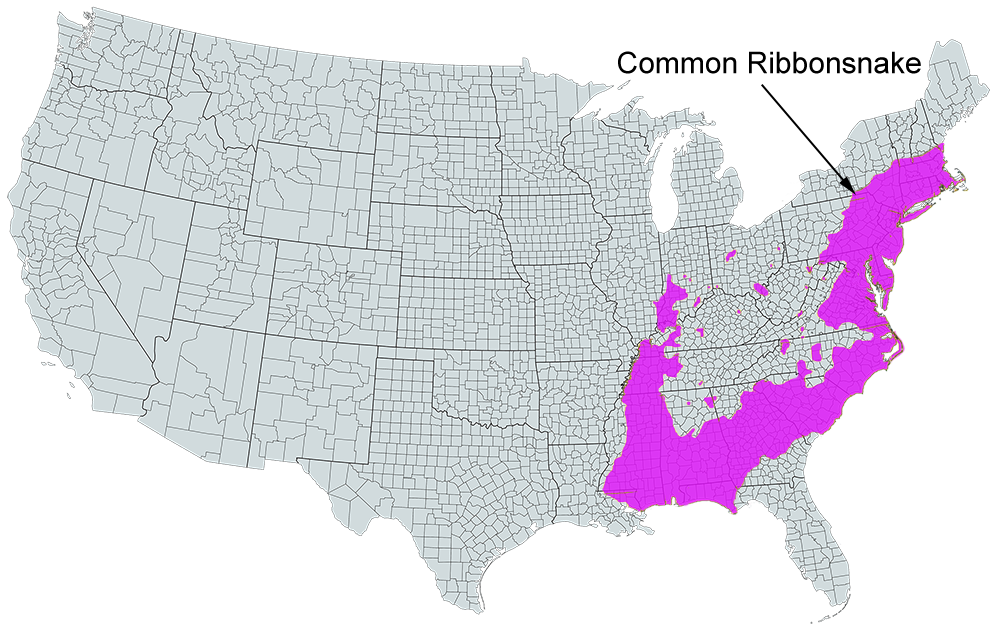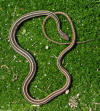Common Ribbonsnake
Thamnophis saurita saurita
** Harmless **
Common Name: |
Common Ribbonsnake |
Scientific Name: |
Thamnophis saurita saurita |
Etymology: |
|
Genus: |
Thamnophis is derived from the Greek words thamnos which means "bush" and ophio meaning "snake". |
Species: |
saurita is derived from the Greek word sauros meaning "lizard", referring to the long lizard-like tail. |
Subspecies: |
saurita is derived from the Greek word sauros meaning "lizard", referring to the long lizard-like tail. |
Vernacular Names: |
Little garter snake, saurite snake, slender grater snake, slim garter snake, spotted ribbon-snake, striped water snake, swift garter snake, swift streaked snake, water garter snake, yellow-headed garter snake. |
Average Length: |
18 - 26 in. (45.7 - 66 cm) |
Virginia Record Length: |
38.2 in (97 cm) |
Record length: |
38.2 in. (97 cm) |
Systematics: Carolus Linnaeus originally described this snake as Coluber saurita in 1766, based on a specimen sent to him by Alexander Garden from "Carolina." Schmidt and Conant (1956) restricted the type locality to Berkeley County, South Carolina. Fitzinger (1843) first used the generic name Thamnophis for this species. In the early Virginia literature, Cope (1875, 1900) used the name Eutaenia saurita, following Baird and Girard (1853). Most Virginia authors, however, used the current combination. Additional comments on the history of the generic name are in the Thamnophis sirtalis account. Four subspecies of sauritis are recognized: T. s. nitae Rossman, T. s. sackenii (Kennicott), T. s. sauritus (Linnaeus), and T. s. septentrionalis Rossman. Rossman (1970) and Conant and Collins (1991) illustrated the distributions of these forms. Kraus and Cameron (2016, Herpetol. Rev. 47: 74–75) corrected the spelling to saurita. Only the nominate subspecies occurs in Virginia.
Description: A slender, medium-sized snake with an exceptionally long tail, reaching a maximum total length of 965 mm (38.0 inches) (Conant and Collins, 1991). In Virginia, maximum known snout-vent length (SVL) is 685 mm (27.0 inches) and maximum total length is 970 mm (38.2 inches). In this study, tail length/total length was 27.2-37.3% (ave. = 32.5 ± 2.4, n = 51).
Scutellation: Ventrals 123-168 (ave. = 153.9 ± 6.4, n = 59); subcaudals 94-132 (ave. = 111.9 ± 8.7, n = 45); ventrals + subcaudals 249-295 (ave. = 266.6 ± 10.3, n = 45); dorsal scales keeled, scale rows 19 at midbody; anal plate single; infralabials 10/10 (63.9%, n = 61) or other combinations of 9-11 (36.1%); supralabials 7/7 (84.4%, n = 64) or other combinations of 6-8 (15.6%); loreal scale present; preoculars 1/1; postoculars 3/3; temporal scales usually 1+2/1+2 (56.1%, n = 66) or other combinations of 1-3 (43.9%).
Coloration and Pattern: Dorsum of body and tail brown to nearly black with 3 bright-yellow to cream stripes; middorsal stripe may be greenish; lateral stripes occur on scale rows 3 and 4; distinct middorsal stripe extends to parietal scales on head; a variable number of dorsal body scales partially edged in white; venter uniform, color varies from greenish to blue-gray; a brown, black, or greenish stripe located on scale rows 1-2 on each side and extends to lateral edges of ventral scales; lateral edges of ventral scales without spots; chin, infralabials, and supralabials white; snout and entire dorsum of head may be brownish.
Sexual Dimorphism: Adult females averaged longer (519.4 ± 79.4 mm SVL, 401-685, n = 17) than males (ave. = 373.4 ± 29.2 mm SVL, 344-413, n = 7), and reached a larger maximum size (females 970 mm, males 617 mm total length). Sexual dimorphism index was 0.39. Tail length relative to total length averaged slightly higher in males (33.9 ± 2.4%, 27.2-37.3, n = 16) than females (31.9 ± 2.1%, 28.3-35.9, n = 35). The average number of ventrals (males 153.2 ± 4.5, 147-165, n = 18; females 155.0 ± 5.2, 144-168, n = 40) was similar between sexes, but males had a slightly higher average number of subcaudals (114.8 ± 10.0, 94-132, n = 14) than females (110.6 ± 7.9, 99-129, n = 31). Consequently, the average number of ventrals + subcaudals was slightly higher in males (268.4 ± 11.5, 249-287, n = 14) than females (265.7 ± 9.8, 250-295, n = 31).
Juveniles: Juveniles are patterned as adults but are brown with bright-yellow or white stripes. The brown dorsal color darkens with age. Neonates were 113-139 mm SVL (ave. = 131.3 ± 9.0, n = 9) and 161-210 mm total length (ave. = 192.8 ± 15.8, n = 8), and weighed 0.8-1.2 g (ave. = 1.0 ± 0.1, n = 8).
Confusing Species: The species most commonly confused with Common Ribbonsnakes is Thamnophis saurita, which has lateral stripes on scale rows 2 and 3. Eastern Gartersnakes have black spots on the lateral margins of the ventral scales and are not as slender as Common Ribbonsnakes. See the below comparison photo.
Biology: Thamnophis saurita is semiaquatic, inhabiting a wide variety of habitats, including freshwater and brackish marshes, grassy floodplains, streams and ditches with grass and brush margins, wet areas in meadows, sphagnum bogs, and woodlands adjacent to wetlands. The primary requirement appears to be accessibility to permanent or semipermanent water. These snakes are somewhat arboreal and are frequently found basking on branches of trees, bushes, or grasses overhanging water. The usual activity season is 22 February to 10 November (based on museum records), but individuals are active on warm days in the winter months. The earliest observation was on 8 January at Back Bay National Wildlife Refuge and the latest on 28 November in New Kent County (N. D. Richmond, pers. comm.). Richmond found one T. saurita individual basking in a sheltered sandy area in a partially frozen marsh on 31 January.
Common Ribbonsnakes are predators of amphibians and small fish. Most predation occurs at night, and prey are swallowed alive. Uhler et al. (1939) reported that two specimens from the George Washington National Forest contained Eastern Cricket Frog (Acris crepitans) and harvester ants. The latter may have actually been prey of an amphibian prey item. Eastern Red-backed Salamanders (Plethodon cinereus), unidentified beetles, lepidopteran larvae, and spiders have been found in other Virginia specimens. Other prey recorded for this species that are found in Virginia are Oak Toads (Anaxyrus quercicus), Southern Toads (Anaxyrus terrestris), Green Treefrogs (Hyla cinerea), Pine Woods Treefrogs (Hyla femoralis), Squirrel Treefrogs (Hyla squirella), Gray Treefrogs (Hyla versicolor), Brimley's Chorus Frogs (Pseudacris brimleyi), Spring Peepers (Pseudacris crucifer), Little Grass Frogs (Pseudacris ocularis), Upland Chorus Frogs (Pseudacris feriarum), juvenile Bullfrogs (Lithobates catesbeianus), Green Frogs (Lithobates clamitans), Pickerel Frogs (Lithobates palustris), Wood Frogs (Lithobates sylvatica), Red-spotted Newts (Notophthalmus viridescens), Spotted Salamanders (Ambystoma maculatum), Mountain Dusky Salamanders (Desmognathus ochrophaeus), Northern Dusky Salamanders (Desmogmthus fuscus), Two-lined Salamanders (Eurycea bislineata), eastern mud minnows (Umbra pygmaea), mosquitofish (Gambusia affinis), and goldfish (Carassius auratus) (Rossman, 1963; Brown, 1979). Linzey and Clifford (1981) speculated that raccoons (Procyon lotor), river otters (Lutra canadensis), minks (Mustek vison), herons (Ardea, Egretta), Eastern Kingsnakes (Lampropeltis getula), Snapping Turtles (Chelydra serpentina), Bullfrogs (Lithobates catesbeiana), bass (Micropterus spp.), and pickerel (Esox spp.) were occasional predators.
Common Ribbonsnakes are viviparous. In Virginia, the smallest mature male measured was 354 mm SVL and the smallest mature female was 422 mm SVL. Rossman (1963) reported that the smallest known mature female (332 mm SVL) was from Pennsylvania. In the northern part of its range, mating occurs in April and May, with oviposition in July and August (Rossman, 1963; Ernst and Barbour, 1989b). In Virginia, known birth dates are 29 July and 6 September. N. D. Richmond (pers. comm.) found newborn juveniles on 25 July and 6 August in New Kent County. Litter size in Virginia was 6-12 (ave. = 9.6 ± 1.9, n = 8). Litter size throughout the range of this species is 3-26 (Ernst and Barbour, 1989b).
The population ecology of this snake has been studied only in Michigan. Carpenter (1952a, 1952b) found that the maximum straightline distance traveled was 278 m, the population density was 32.2 per hectare, juvenile growth was about 12-24 mm per month, and adult growth was about 1-4 mm per month. In Virginia, this species appeared to be more common in the Coastal Plain (45 specimens) than the Piedmont (9), Blue Ridge Mountains (1), or Ridge and Valley (4). This is probably related to the abundance of wetland habitat in the Coastal Plain and the scattered locations of suitable habitat elsewhere. Three Virginia studies noting relative abundance of snake species (Uhler et al., 1939; Clifford, 1976; Martin, 1976) recorded only two ribbon snakes.
This is an active and nervous snake and will thrash about when caught, although it will seldom bite. It is not easy to catch because it swiftly escapes in the grass and brush habitat. Like most natricines, it will spray musk from glands at the base of the tail and sometimes feces as well.
Remarks: Other common names in Virginia are riband snake (Hay, 1902), and slender garter snake, striped water snake, and striped racer (Linzey and Clifford, 1981).
Conservation and Management: Thamnophis saurita is not considered a species of special concern in Virginia. It may, however, be an indicator of the health of marsh and other wetland habitats. Because this snake feeds on amphibians, fish, and invertebrates, it may quickly succumb to biological accumulation of pesticides and other pollutants. Brisbin et al. (1974) found high concentrations of radioactive cesium in Common Ribbonsnakes from a nearby nuclear power plant in South Carolina. Studies of the population ecology and contaminant levels of T. saurita and its prey resources could yield important information on the dynamics and health of wetland ecosystems. Records of this species should be maintained in conjunction with locations of wetlands so that its status and habitat in Virginia can be monitored.
References for Life History
Photos:
*Click on a thumbnail for a larger version.
Verified County/City Occurrence in Virginia
Albemarle
Amelia
Arlington
Augusta
Botetourt
Campbell
Carroll
Charles City
Charlotte
Chesterfield
Culpeper
Cumberland
Fairfax
Fauquier
Floyd
Gloucester
Grayson
Greene
Greensville
Hanover
Henrico
Isle of Wight
James City
King George
Lancaster
Loudoun
Louisa
Madison
Mecklenburg
Montgomery
Nelson
New Kent
Northampton
Nottoway
Page
Powhatan
Prince Edward
Prince George
Richmond
Roanoke
Rockbridge
Rockingham
Southampton
Spotsylvania
Stafford
Surry
Sussex
Warren
Westmoreland
York
CITIES
Alexandria
Chesapeake
Newport News
Norfolk
Richmond
Suffolk
Virginia Beach
Verified in 50 counties and 7 cities.
U.S. Range

US range map based on work done by The Center for North American Herpetology (cnah.org) and Travis W. Taggart.







